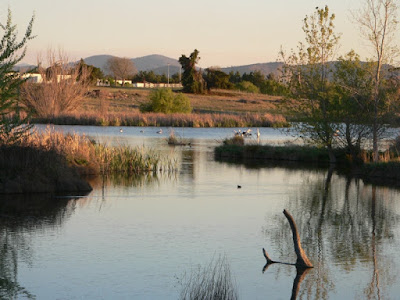Well, one could very justifiably argue that any number of other dates could fit that description of course, but I've opted for the day in 1963 that the weir gates closed on Scrivener Dam and the lake which is the centrepiece of Canberra, Australia's capital city, began to fill. As it happened that was a drought year and flow in the Molonglo River was minimal, so it took until the following March for the desired water level to be achieved.
The city centre and the national institutions are all built on or near the shores of the lake, which have hitherto (mostly) been kept clear for public use.
It is a substantial body of water 11km long and over a kilometre wide, and an average of four metres deep. Theoretically power boats are banned to retain the peaceful nature of the water body, but permits to avoid this restriction seem to be available for a range of purposes. On the whole however it is a calm and beautiful focal point, and is a haven for wildlife. The rest of this post will be a simple celebration of some of that wildlife; much of it comprises common birds, including of course many waterbirds, but even common birds are very welcome in the heart of a city! Fish in the lake - mostly carp, sadly - support a good population of four species of cormorants, plus darters and pelicans.
 |
| Little Pied Cormorant Microcarbo melanoleucos.One of the world's smallest cormorants, this species is familiar throughout Australia, north into Indonesia and across the Tasman Sea in New Zealand. |
 | |
| Great Cormorants Phalacrocorax carbo are found on every unfrozen continent except South America, though it is possible that more than one species is involved. |
 |
| Australian Wood Duck pair Chenonetta jubata, female on the left. A common grazing duck of uncertain relationships. |
 |
| Black Swans Cygnus atratus are common on the lake, breeding in floating weed nests starting in winter. |
 |
| Black Swan cygnet. |
Land birds can be seen anywhere around the shores, but the woodland and forest remnants at the western end of the lake, especially near Yarramundi Reach, are especially productive, along with the Bulrush beds just off shore.
 |
| Bulrush, Typha sp., Yarrumundi Reach; such stands support many shelter-loving small passerines, as well as species of crake and even bitterns. |
 |
| Australasian Reed Warblers Acrocephalus australis make the reed beds raucous with their metallic territorial calls in spring and summer, going north to warmer parts of the continent in winter. |
 |
| Superb Fairy-wren Malurus cyaneus male; one of the most familiar and 'popular' urban birds of south-eastern Australia. |
 |
| The Dusky Woodswallow Artamus cyanopterus is another migrant which is usually to be found in spring and summer at Yarramundi Reach. |
Even the open spaces can be rewarding however.
 |
| Welcome Swallows Hirundo neoxena. |
 |
| Water Rats Hydromys chrysogaster can often be seen in the daytime on the shore or swimming strongly, especially in the vicinity of the Carillon. |
By far the richest area of the lake however is found at the eastern end, near where the Molonglo and Jerrabomberra Creek both flow into the lake. Jerrabomberra Wetlands are protected as part of Canberra Nature Park. Large areas are reserved for research and refuge, based around the palaeochannels of the Molonglo, but the area around Kellys Swamp is one of my favourite local birding and general natural history sites around here. Over the years I've seen over 140 species here.
 |
| Kellys Swamp in the evening. This is an ephemeral pan which these days is kept inundated from Jerrabomberra Creek in all but the driest seasons. |
Here is a small selection of some of my favourite memories there in the decade or so since I 'went digital'.
 |
| Glossy Ibis Plegadis falcinellus, an uncommon visitor to our part of the world. |
 |
| Great Egret Ardea alba alighting; a common visitor, but I liked this moment (unfortunate shadow notwithstanding!). |
 |
| Royal Spoonbill Platalea regia, in full breeding glory. |
 |
| Yellow-billed Spoonbills Platalea flavipes are much less common visitors to Jerrabomberra. |
 |
| Black-backed Bittern Ixobrychus dubius lurking among the bulrushes. Another very hard to see bird, but not because of its rarity. |
 |
| Australian Spotted Crake Porzana fluminea; when low water levels expose the mud, crakes and other normally elusive rails appear. Always exciting times! |
 |
| Freckled Duck Stictonetta naevosa, another threatened species which turns up not infrequently at Jerrabomberra. |
The now mature plantings around the swamp also attract an array of locally uncommon species, including these two honeyeaters which are not often recorded in Canberra.
 |
| Yellow-plumed Honeyeater Lichenostomus melanops. |
 |
| Fuscous Honeyeater Ptilotula fusca harvesting honeydew. |
While the birds tend to be the main attraction - and I could have selected many more! - they are not the only ones.
 |
| Brush-tailed Possum Trichosurus vulpeculus and joey, which took up residence in one of the hides for a while. |
 |
| Chequered Copper Lucia limbaria. |
 |
| Fiddler Beetle Eupoecila australasiae on Bursaria spinosa. |
Every time I spend time by Lake Burley Griffin I am grateful to the Griffins for having had the vision, and to those who carried the vision through to the reality, decades after their deaths.
NEXT POSTING THURSDAY
(And
remember that you can get a reminder when the next post appears by
putting your email address in the Follow by Email box in the top right
of this screen.)








No comments:
Post a Comment